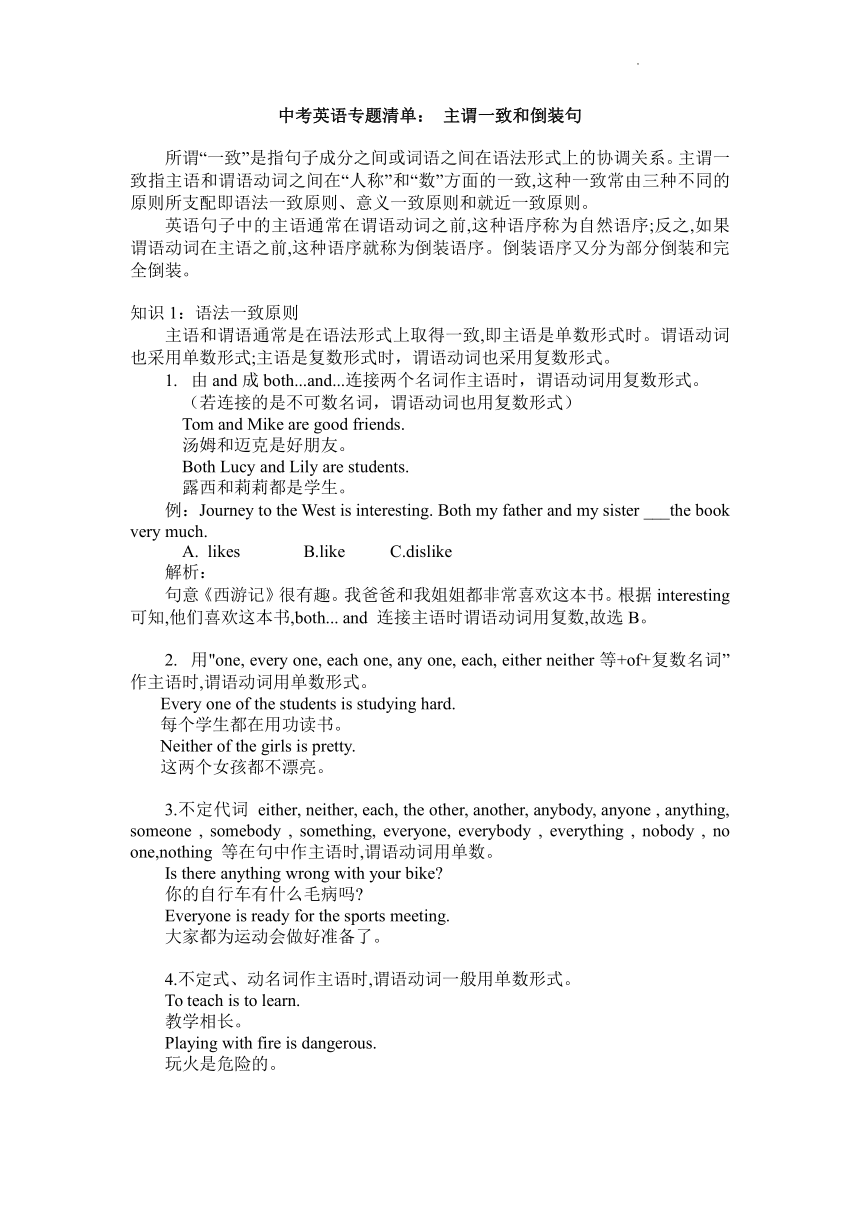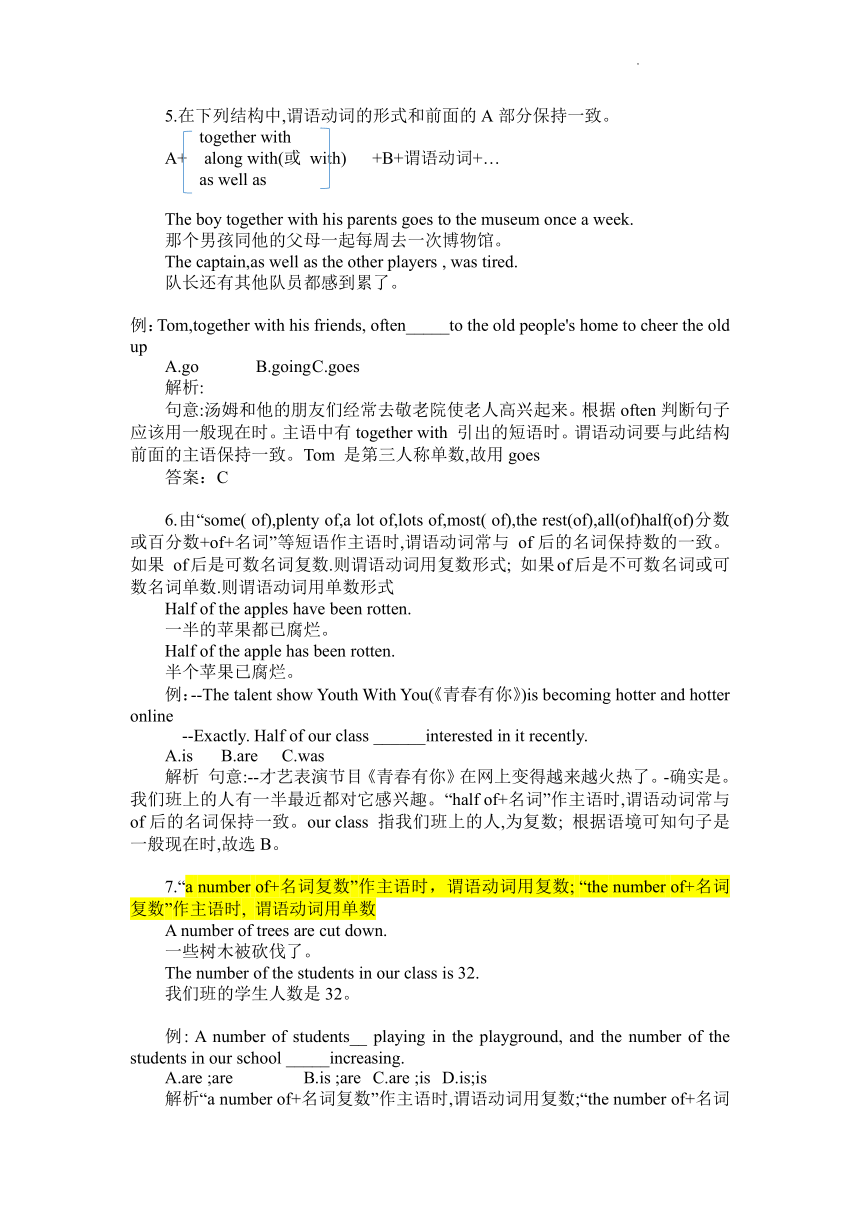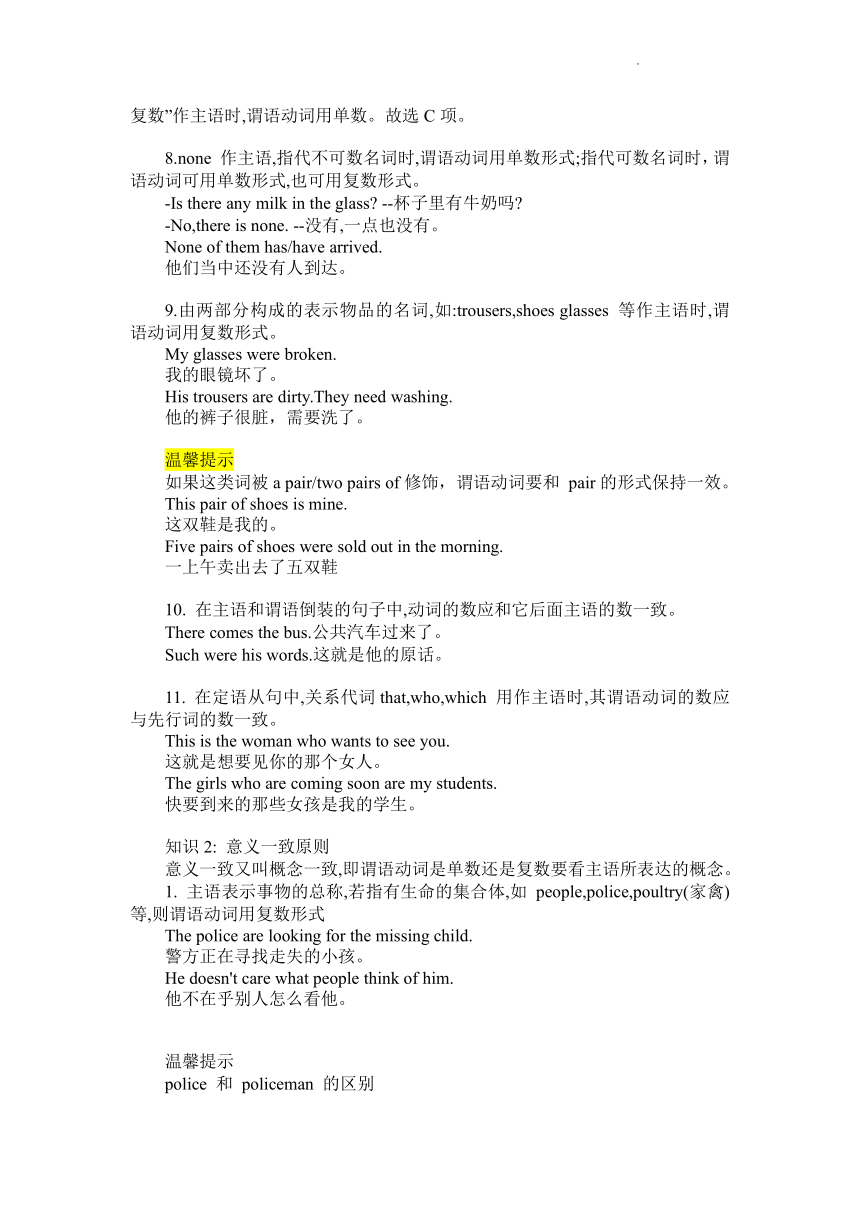2022年中考英语专题清单:主谓一致和倒装句
文档属性
| 名称 | 2022年中考英语专题清单:主谓一致和倒装句 |

|
|
| 格式 | docx | ||
| 文件大小 | 41.4KB | ||
| 资源类型 | 教案 | ||
| 版本资源 | 通用版 | ||
| 科目 | 英语 | ||
| 更新时间 | 2022-04-07 14:09:48 | ||
图片预览



文档简介
中考英语专题清单: 主谓一致和倒装句
所谓“一致”是指句子成分之间或词语之间在语法形式上的协调关系。主谓一致指主语和谓语动词之间在“人称”和“数”方面的一致,这种一致常由三种不同的原则所支配即语法一致原则、意义一致原则和就近一致原则。
英语句子中的主语通常在谓语动词之前,这种语序称为自然语序;反之,如果谓语动词在主语之前,这种语序就称为倒装语序。倒装语序又分为部分倒装和完全倒装。
知识1:语法一致原则
主语和谓语通常是在语法形式上取得一致,即主语是单数形式时。谓语动词也采用单数形式;主语是复数形式时,谓语动词也采用复数形式。
由and成both...and...连接两个名词作主语时,谓语动词用复数形式。
(若连接的是不可数名词,谓语动词也用复数形式)
Tom and Mike are good friends.
汤姆和迈克是好朋友。
Both Lucy and Lily are students.
露西和莉莉都是学生。
例:Journey to the West is interesting. Both my father and my sister ___the book very much.
likes B.like C.dislike
解析:
句意《西游记》很有趣。我爸爸和我姐姐都非常喜欢这本书。根据interesting可知,他们喜欢这本书,both... and 连接主语时谓语动词用复数,故选B。
用"one, every one, each one, any one, each, either neither等+of+复数名词”作主语时,谓语动词用单数形式。
Every one of the students is studying hard.
每个学生都在用功读书。
Neither of the girls is pretty.
这两个女孩都不漂亮。
3.不定代词 either, neither, each, the other, another, anybody, anyone , anything, someone , somebody , something, everyone, everybody , everything , nobody , no one,nothing 等在句中作主语时,谓语动词用单数。
Is there anything wrong with your bike
你的自行车有什么毛病吗
Everyone is ready for the sports meeting.
大家都为运动会做好准备了。
4.不定式、动名词作主语时,谓语动词一般用单数形式。
To teach is to learn.
教学相长。
Playing with fire is dangerous.
玩火是危险的。
5.在下列结构中,谓语动词的形式和前面的A部分保持一致。
together with
A+ along with(或 with) +B+谓语动词+…
as well as
The boy together with his parents goes to the museum once a week.
那个男孩同他的父母一起每周去一次博物馆。
The captain,as well as the other players , was tired.
队长还有其他队员都感到累了。
例:Tom,together with his friends, often_____to the old people's home to cheer the old up
A.go B.going C.goes
解析:
句意:汤姆和他的朋友们经常去敬老院使老人高兴起来。根据often判断句子应该用一般现在时。主语中有together with 引出的短语时。谓语动词要与此结构前面的主语保持一致。Tom 是第三人称单数,故用goes
答案:C
6.由“some( of),plenty of,a lot of,lots of,most( of),the rest(of),all(of)half(of)分数或百分数+of+名词”等短语作主语时,谓语动词常与 of后的名词保持数的一致。如果 of后是可数名词复数.则谓语动词用复数形式; 如果of后是不可数名词或可数名词单数.则谓语动词用单数形式
Half of the apples have been rotten.
一半的苹果都已腐烂。
Half of the apple has been rotten.
半个苹果已腐烂。
例:--The talent show Youth With You(《青春有你》)is becoming hotter and hotter online
--Exactly. Half of our class ______interested in it recently.
A.is B.are C.was
解析 句意:--才艺表演节目《青春有你》在网上变得越来越火热了。-确实是。我们班上的人有一半最近都对它感兴趣。“half of+名词”作主语时,谓语动词常与 of后的名词保持一致。our class 指我们班上的人,为复数; 根据语境可知句子是一般现在时,故选B。
7.“a number of+名词复数”作主语时,谓语动词用复数; “the number of+名词复数”作主语时, 谓语动词用单数
A number of trees are cut down.
一些树木被砍伐了。
The number of the students in our class is 32.
我们班的学生人数是32。
例: A number of students__ playing in the playground, and the number of the students in our school _____increasing.
A.are ;are B.is ;are C.are ;is D.is;is
解析“a number of+名词复数”作主语时,谓语动词用复数;“the number of+名词复数”作主语时,谓语动词用单数。故选C项。
8.none 作主语,指代不可数名词时,谓语动词用单数形式;指代可数名词时,谓语动词可用单数形式,也可用复数形式。
-Is there any milk in the glass --杯子里有牛奶吗
-No,there is none. --没有,一点也没有。
None of them has/have arrived.
他们当中还没有人到达。
9.由两部分构成的表示物品的名词,如:trousers,shoes glasses 等作主语时,谓语动词用复数形式。
My glasses were broken.
我的眼镜坏了。
His trousers are dirty.They need washing.
他的裤子很脏,需要洗了。
温馨提示
如果这类词被a pair/two pairs of修饰,谓语动词要和 pair的形式保持一效。
This pair of shoes is mine.
这双鞋是我的。
Five pairs of shoes were sold out in the morning.
一上午卖出去了五双鞋
在主语和谓语倒装的句子中,动词的数应和它后面主语的数一致。
There comes the bus.公共汽车过来了。
Such were his words.这就是他的原话。
在定语从句中,关系代词that,who,which 用作主语时,其谓语动词的数应与先行词的数一致。
This is the woman who wants to see you.
这就是想要见你的那个女人。
The girls who are coming soon are my students.
快要到来的那些女孩是我的学生。
知识2: 意义一致原则
意义一致又叫概念一致,即谓语动词是单数还是复数要看主语所表达的概念。
主语表示事物的总称,若指有生命的集合体,如 people,police,poultry(家禽)等,则谓语动词用复数形式
The police are looking for the missing child.
警方正在寻找走失的小孩。
He doesn't care what people think of him.
他不在乎别人怎么看他。
温馨提示
police 和 policeman 的区别
“police”作主语时,指有生命的集合体,是复数概念,谓语动词用复数;“policeman”作主语时,指个体,是单数概念,谓语动词用单数形式。
The policeman is 38 years old.
那个警察 38岁了。
The police are looking for the murderer.
警方正在寻找杀人凶手。
2.主语表示事物的总称,若指无生命的集合体,如 clothing,fruit,equipment,traffic,jewellery 等,则谓语动词用单数形式。
Our warm clothing protects us against the cold.
保暖的衣服保护我们不受寒冷。
There isn't any traffic on the road at the moment.
这会儿路上没有车辆往来。
3.主语为集体名词,如family,team,staff,class,group government 等,若表示整体概念,其谓语动词须用单数形式若表示集体中的成员,其谓语动词须用复数形式。
My family is a small one.
我家是一个小家庭。
My family all like classical music.
我们全家都喜欢古典音乐。
4.有些复数形式的名词作主语时,谓语动词用单数形式。
常见的有:抽象名词(如:news),学科名词(如:maths. physics),专有名词(如:James,the United States,Arabian Nigh ts《天方夜谭》)游戏、运动名词(如:billiards 台球)等。而clothes,goods,works(著作),the Olympic Games 等几个词或短语作主语时,谓语动词用复数形式。
The United States was founded in 1776.
美国成立于1776 年。
Physics is very interesting.We all like it.
物理很有意思,我们都喜欢它。
The expensive clothes were made specially for the beautiful princess.
这些昂贵的衣服是专门为美丽的公主制作的。
5.“the+形容词”作主语,若表示一类人,谓语动词用复数;若表示一种抽象概念或品质,谓语动词用单数。
The rich are not always happy.
富人并不总是快乐的。
The beautiful gives pleasure to all of us.
美的东西会给我们大家带来快乐。
例:I don't think the poor______poor.
A.are always B.is always C.always be
解析: “the+形容词”表示一类人,后面的谓语动词应该用复数形式,故选A。
6.表示时间、长度、价格、质量等的短语作主语时,应将它们作为一个整体看待,即使其中的名词为复数形式,谓语动词也应用第三人称单数形式。
Three years has passed quickly.三年的时间很快过去了。
Fifty yuan is enough.五十元钱足够了。
例-Do you need more time to complete the task -Yes. Another ten days _____enough.
A.is B.was
C.are D.were
解析 由语境可知此处应用一般现在时,可先排除B、D。
表示一段时间的短语作主语时,谓语动词用单数。故选A项。
由and连接的两个名词作主语,如果是指同一概念(即and 后而无冠词)时,谓语动词用单数形式。
The singer and dancer has been invited to the party.
那位歌唱家兼舞蹈家被邀请参加聚会了。
8."each/every/no+名词+and+each/every/no+名词”作主语时,谓语动词仍用单数形式。
Each boy and each girl wants to have a good job in the future.
每个男孩和每个女孩都希望将来能有份好工作。
9."many a/an+名词单数"或"more than one+名词单数"作主语时,谓语动词要用单数形式。"more+可数名词复数+ than one"作主语时,谓语动词用复数。
Many a person has read the novel.
许多人都读过这部小说。
More members than one are against your plan.
不止一个成员反对你的计划。
知识 3: 就近一致原则
有时谓语动词的形式与邻近它的名词或代词一致,这种原则叫就近一致原则。
1.由 either...or..., neither...nor..., not only...but ( also )..或 or 连接两个并列主语时,其谓语动词的单复数形式需与并列主语中“邻近”的那一部分保持一致
Neither her sisters nor Mary is going to the party tomorrow.
玛丽和她的妹妹们明天都不去参加聚会。
Not only my parents but also I am looking forward to meeting my uncle.
不但我父母而且我也盼望着见到我叔叔。
例1 : Neither Li Hua nor I_____good at writing.
A.am B.is C.are
解析 句意:李华和我都不擅长写作。neither...nor...连接两个主语时.谓语动词的形式要遵循就近一致原则,此时主语I离谓语近,故选A项。
答案 A
例2: ____Tom_____Mary speaks good Chinese,so they can communicate with these Chinese students very well.
A.Neither ;nor B.Not only;but also
C.Both;and D.Either;or
解析:
句意:不仅 Tom,Mary的汉语也讲得很好,所以他们能和这些中国学生很好地交流。neither...nor…既不……也不……; not only...but also...不仅……而且……; both. and………和……两者都;either...or….或者……或者……根据句意和谓语动词speaks,可知B项为正确答案。
2.there be...和 here be.这两个句式中的be 常遵循就近一致原则。
例:-- _____ an amusement center, some restaurants and hundreds of stores in the shopping mall.
-- Wow,it's amazing. I will go next week.
A.There is B.There are C .There will be
解析:
There be 句型中谓语动遵循就近原则根据空后an amusement center 可知,谓语动同用单数形式。根据语境可知,本句为一般现在时,故选A
知识4: 倒装句
如果谓语提到主语前面,则句子为倒装语序
1.no,neither/nor 引起的倒装
结构:
so+助动词/be动词/情态动词+主语
neither/nor+助动词/be 动词/情态动词+主语
当前句所说的肯定情况同样适用于后面的人或物时。用so结构,表示某人/某物也这样;当前句所说的否定情况同样适用于后面的人或物时,用neither/nor结构,表示某人某物也不……
这种结构中的助动词、be动词或情态动词的选择在形式上要与前面句子的谓语保持一致,但其单复数则由后面的主语决定。
Lucy is a good student, and so is Lily.
露西是一个好学生,莉莉也是(一个好学生)。
Lucy likes Chinese, and so does Lily.
露西喜欢汉语,莉莉也喜欢。
You can't play the piano and neither/nor can I.
你不会弹钢琴,我也不会,
Mary didn't watch TV last night and neither/nor did Jim.
玛丽昨晚没看电视,吉姆也没看(电视)。
温馨提示
“so+助动词/be 动词/情态动词+主语”与“so+主语+助动词/be 动词/情态动词”的区别
①-Tom passed the driving test. --汤姆通过驾照考试了。
-So did he.--他也通过了。(“he”指另外一位男士而不是汤姆)
②-Tom passed the driving test. --汤姆通过驾照考试了。
-So he did.--他的确通过了。(“he”指汤姆)
2.there be 句型的倒装
there be 句型是一个表示“存在”的句型,是主语在be动词后面的倒装句,谓语动词的单复数遵循就近一致原则。
There is a tree in front of the building.大楼前有一棵树。
3.方位副词引起的倒装
在以 here,there,out,in,down,away等表示方位的副词开头的句子中,当主语是名词时,要用倒装,谓语动词的形式由位于倒装句句尾的主语决定。
Away went the football fans.
球迷们走了。
Here is a flower.
这儿有一朵花。
温馨提示
如果主语是代词,就不再用倒装。
Here you are. 给你。
Here it is. 给你。/在这里。
4.地点状语或表语放在句首时引起的倒装
West of the lake lies the famous city.
湖的西边坐落着那座著名的城市。
Behind the farmhouse was a rice field.
农舍后面是一片稻田。
所谓“一致”是指句子成分之间或词语之间在语法形式上的协调关系。主谓一致指主语和谓语动词之间在“人称”和“数”方面的一致,这种一致常由三种不同的原则所支配即语法一致原则、意义一致原则和就近一致原则。
英语句子中的主语通常在谓语动词之前,这种语序称为自然语序;反之,如果谓语动词在主语之前,这种语序就称为倒装语序。倒装语序又分为部分倒装和完全倒装。
知识1:语法一致原则
主语和谓语通常是在语法形式上取得一致,即主语是单数形式时。谓语动词也采用单数形式;主语是复数形式时,谓语动词也采用复数形式。
由and成both...and...连接两个名词作主语时,谓语动词用复数形式。
(若连接的是不可数名词,谓语动词也用复数形式)
Tom and Mike are good friends.
汤姆和迈克是好朋友。
Both Lucy and Lily are students.
露西和莉莉都是学生。
例:Journey to the West is interesting. Both my father and my sister ___the book very much.
likes B.like C.dislike
解析:
句意《西游记》很有趣。我爸爸和我姐姐都非常喜欢这本书。根据interesting可知,他们喜欢这本书,both... and 连接主语时谓语动词用复数,故选B。
用"one, every one, each one, any one, each, either neither等+of+复数名词”作主语时,谓语动词用单数形式。
Every one of the students is studying hard.
每个学生都在用功读书。
Neither of the girls is pretty.
这两个女孩都不漂亮。
3.不定代词 either, neither, each, the other, another, anybody, anyone , anything, someone , somebody , something, everyone, everybody , everything , nobody , no one,nothing 等在句中作主语时,谓语动词用单数。
Is there anything wrong with your bike
你的自行车有什么毛病吗
Everyone is ready for the sports meeting.
大家都为运动会做好准备了。
4.不定式、动名词作主语时,谓语动词一般用单数形式。
To teach is to learn.
教学相长。
Playing with fire is dangerous.
玩火是危险的。
5.在下列结构中,谓语动词的形式和前面的A部分保持一致。
together with
A+ along with(或 with) +B+谓语动词+…
as well as
The boy together with his parents goes to the museum once a week.
那个男孩同他的父母一起每周去一次博物馆。
The captain,as well as the other players , was tired.
队长还有其他队员都感到累了。
例:Tom,together with his friends, often_____to the old people's home to cheer the old up
A.go B.going C.goes
解析:
句意:汤姆和他的朋友们经常去敬老院使老人高兴起来。根据often判断句子应该用一般现在时。主语中有together with 引出的短语时。谓语动词要与此结构前面的主语保持一致。Tom 是第三人称单数,故用goes
答案:C
6.由“some( of),plenty of,a lot of,lots of,most( of),the rest(of),all(of)half(of)分数或百分数+of+名词”等短语作主语时,谓语动词常与 of后的名词保持数的一致。如果 of后是可数名词复数.则谓语动词用复数形式; 如果of后是不可数名词或可数名词单数.则谓语动词用单数形式
Half of the apples have been rotten.
一半的苹果都已腐烂。
Half of the apple has been rotten.
半个苹果已腐烂。
例:--The talent show Youth With You(《青春有你》)is becoming hotter and hotter online
--Exactly. Half of our class ______interested in it recently.
A.is B.are C.was
解析 句意:--才艺表演节目《青春有你》在网上变得越来越火热了。-确实是。我们班上的人有一半最近都对它感兴趣。“half of+名词”作主语时,谓语动词常与 of后的名词保持一致。our class 指我们班上的人,为复数; 根据语境可知句子是一般现在时,故选B。
7.“a number of+名词复数”作主语时,谓语动词用复数; “the number of+名词复数”作主语时, 谓语动词用单数
A number of trees are cut down.
一些树木被砍伐了。
The number of the students in our class is 32.
我们班的学生人数是32。
例: A number of students__ playing in the playground, and the number of the students in our school _____increasing.
A.are ;are B.is ;are C.are ;is D.is;is
解析“a number of+名词复数”作主语时,谓语动词用复数;“the number of+名词复数”作主语时,谓语动词用单数。故选C项。
8.none 作主语,指代不可数名词时,谓语动词用单数形式;指代可数名词时,谓语动词可用单数形式,也可用复数形式。
-Is there any milk in the glass --杯子里有牛奶吗
-No,there is none. --没有,一点也没有。
None of them has/have arrived.
他们当中还没有人到达。
9.由两部分构成的表示物品的名词,如:trousers,shoes glasses 等作主语时,谓语动词用复数形式。
My glasses were broken.
我的眼镜坏了。
His trousers are dirty.They need washing.
他的裤子很脏,需要洗了。
温馨提示
如果这类词被a pair/two pairs of修饰,谓语动词要和 pair的形式保持一效。
This pair of shoes is mine.
这双鞋是我的。
Five pairs of shoes were sold out in the morning.
一上午卖出去了五双鞋
在主语和谓语倒装的句子中,动词的数应和它后面主语的数一致。
There comes the bus.公共汽车过来了。
Such were his words.这就是他的原话。
在定语从句中,关系代词that,who,which 用作主语时,其谓语动词的数应与先行词的数一致。
This is the woman who wants to see you.
这就是想要见你的那个女人。
The girls who are coming soon are my students.
快要到来的那些女孩是我的学生。
知识2: 意义一致原则
意义一致又叫概念一致,即谓语动词是单数还是复数要看主语所表达的概念。
主语表示事物的总称,若指有生命的集合体,如 people,police,poultry(家禽)等,则谓语动词用复数形式
The police are looking for the missing child.
警方正在寻找走失的小孩。
He doesn't care what people think of him.
他不在乎别人怎么看他。
温馨提示
police 和 policeman 的区别
“police”作主语时,指有生命的集合体,是复数概念,谓语动词用复数;“policeman”作主语时,指个体,是单数概念,谓语动词用单数形式。
The policeman is 38 years old.
那个警察 38岁了。
The police are looking for the murderer.
警方正在寻找杀人凶手。
2.主语表示事物的总称,若指无生命的集合体,如 clothing,fruit,equipment,traffic,jewellery 等,则谓语动词用单数形式。
Our warm clothing protects us against the cold.
保暖的衣服保护我们不受寒冷。
There isn't any traffic on the road at the moment.
这会儿路上没有车辆往来。
3.主语为集体名词,如family,team,staff,class,group government 等,若表示整体概念,其谓语动词须用单数形式若表示集体中的成员,其谓语动词须用复数形式。
My family is a small one.
我家是一个小家庭。
My family all like classical music.
我们全家都喜欢古典音乐。
4.有些复数形式的名词作主语时,谓语动词用单数形式。
常见的有:抽象名词(如:news),学科名词(如:maths. physics),专有名词(如:James,the United States,Arabian Nigh ts《天方夜谭》)游戏、运动名词(如:billiards 台球)等。而clothes,goods,works(著作),the Olympic Games 等几个词或短语作主语时,谓语动词用复数形式。
The United States was founded in 1776.
美国成立于1776 年。
Physics is very interesting.We all like it.
物理很有意思,我们都喜欢它。
The expensive clothes were made specially for the beautiful princess.
这些昂贵的衣服是专门为美丽的公主制作的。
5.“the+形容词”作主语,若表示一类人,谓语动词用复数;若表示一种抽象概念或品质,谓语动词用单数。
The rich are not always happy.
富人并不总是快乐的。
The beautiful gives pleasure to all of us.
美的东西会给我们大家带来快乐。
例:I don't think the poor______poor.
A.are always B.is always C.always be
解析: “the+形容词”表示一类人,后面的谓语动词应该用复数形式,故选A。
6.表示时间、长度、价格、质量等的短语作主语时,应将它们作为一个整体看待,即使其中的名词为复数形式,谓语动词也应用第三人称单数形式。
Three years has passed quickly.三年的时间很快过去了。
Fifty yuan is enough.五十元钱足够了。
例-Do you need more time to complete the task -Yes. Another ten days _____enough.
A.is B.was
C.are D.were
解析 由语境可知此处应用一般现在时,可先排除B、D。
表示一段时间的短语作主语时,谓语动词用单数。故选A项。
由and连接的两个名词作主语,如果是指同一概念(即and 后而无冠词)时,谓语动词用单数形式。
The singer and dancer has been invited to the party.
那位歌唱家兼舞蹈家被邀请参加聚会了。
8."each/every/no+名词+and+each/every/no+名词”作主语时,谓语动词仍用单数形式。
Each boy and each girl wants to have a good job in the future.
每个男孩和每个女孩都希望将来能有份好工作。
9."many a/an+名词单数"或"more than one+名词单数"作主语时,谓语动词要用单数形式。"more+可数名词复数+ than one"作主语时,谓语动词用复数。
Many a person has read the novel.
许多人都读过这部小说。
More members than one are against your plan.
不止一个成员反对你的计划。
知识 3: 就近一致原则
有时谓语动词的形式与邻近它的名词或代词一致,这种原则叫就近一致原则。
1.由 either...or..., neither...nor..., not only...but ( also )..或 or 连接两个并列主语时,其谓语动词的单复数形式需与并列主语中“邻近”的那一部分保持一致
Neither her sisters nor Mary is going to the party tomorrow.
玛丽和她的妹妹们明天都不去参加聚会。
Not only my parents but also I am looking forward to meeting my uncle.
不但我父母而且我也盼望着见到我叔叔。
例1 : Neither Li Hua nor I_____good at writing.
A.am B.is C.are
解析 句意:李华和我都不擅长写作。neither...nor...连接两个主语时.谓语动词的形式要遵循就近一致原则,此时主语I离谓语近,故选A项。
答案 A
例2: ____Tom_____Mary speaks good Chinese,so they can communicate with these Chinese students very well.
A.Neither ;nor B.Not only;but also
C.Both;and D.Either;or
解析:
句意:不仅 Tom,Mary的汉语也讲得很好,所以他们能和这些中国学生很好地交流。neither...nor…既不……也不……; not only...but also...不仅……而且……; both. and………和……两者都;either...or….或者……或者……根据句意和谓语动词speaks,可知B项为正确答案。
2.there be...和 here be.这两个句式中的be 常遵循就近一致原则。
例:-- _____ an amusement center, some restaurants and hundreds of stores in the shopping mall.
-- Wow,it's amazing. I will go next week.
A.There is B.There are C .There will be
解析:
There be 句型中谓语动遵循就近原则根据空后an amusement center 可知,谓语动同用单数形式。根据语境可知,本句为一般现在时,故选A
知识4: 倒装句
如果谓语提到主语前面,则句子为倒装语序
1.no,neither/nor 引起的倒装
结构:
so+助动词/be动词/情态动词+主语
neither/nor+助动词/be 动词/情态动词+主语
当前句所说的肯定情况同样适用于后面的人或物时。用so结构,表示某人/某物也这样;当前句所说的否定情况同样适用于后面的人或物时,用neither/nor结构,表示某人某物也不……
这种结构中的助动词、be动词或情态动词的选择在形式上要与前面句子的谓语保持一致,但其单复数则由后面的主语决定。
Lucy is a good student, and so is Lily.
露西是一个好学生,莉莉也是(一个好学生)。
Lucy likes Chinese, and so does Lily.
露西喜欢汉语,莉莉也喜欢。
You can't play the piano and neither/nor can I.
你不会弹钢琴,我也不会,
Mary didn't watch TV last night and neither/nor did Jim.
玛丽昨晚没看电视,吉姆也没看(电视)。
温馨提示
“so+助动词/be 动词/情态动词+主语”与“so+主语+助动词/be 动词/情态动词”的区别
①-Tom passed the driving test. --汤姆通过驾照考试了。
-So did he.--他也通过了。(“he”指另外一位男士而不是汤姆)
②-Tom passed the driving test. --汤姆通过驾照考试了。
-So he did.--他的确通过了。(“he”指汤姆)
2.there be 句型的倒装
there be 句型是一个表示“存在”的句型,是主语在be动词后面的倒装句,谓语动词的单复数遵循就近一致原则。
There is a tree in front of the building.大楼前有一棵树。
3.方位副词引起的倒装
在以 here,there,out,in,down,away等表示方位的副词开头的句子中,当主语是名词时,要用倒装,谓语动词的形式由位于倒装句句尾的主语决定。
Away went the football fans.
球迷们走了。
Here is a flower.
这儿有一朵花。
温馨提示
如果主语是代词,就不再用倒装。
Here you are. 给你。
Here it is. 给你。/在这里。
4.地点状语或表语放在句首时引起的倒装
West of the lake lies the famous city.
湖的西边坐落着那座著名的城市。
Behind the farmhouse was a rice field.
农舍后面是一片稻田。
同课章节目录
- 词法
- 名词
- 动词和动词短语
- 动词语态
- 动词时态
- 助动词和情态动词
- 非谓语动词
- 冠词
- 代词
- 数词和量词
- 形容词副词及其比较等级
- 介词和介词短语
- 连词和感叹词
- 构词法
- 相似、相近词比较
- 句法
- 陈述句
- 一般疑问句和否定疑问句
- 特殊疑问句及选择疑问句
- 反意疑问句
- 存在句(There be句型)
- 宾语从句
- 定语从句
- 状语从句
- 主谓一致问题
- 简单句
- 并列句
- 复合句
- 主谓一致
- 主、表语从句
- 名词性从句
- 直接引语和间接引语
- 虚拟语气
- 感叹句
- 强调句
- 倒装句
- 祈使句
- 句子的成分
- 句子的分类
- 题型专区
- 单项选择部分
- 易错题
- 完形填空
- 阅读理解
- 词汇练习
- 听说训练
- 句型转换
- 补全对话
- 短文改错
- 翻译
- 书面表达
- 任务型阅读
- 语法填空
- 其他资料
